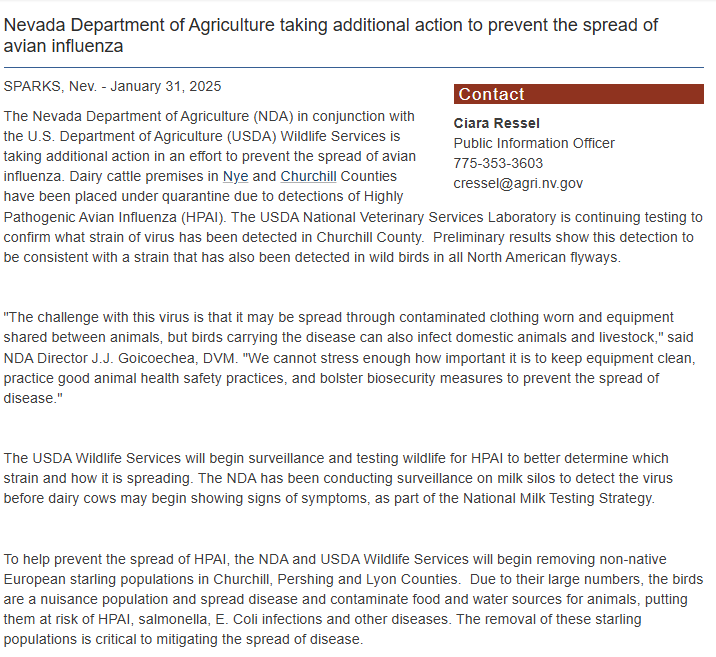The USDA has confirmed that Nevada dairy cattle herds have been infected with H5N1 genotype D1.1, the strain circulating in birds, as opposed to genotype B3.13, the strain we have seen moving through dairy cattle in the U.S. This is the first time this strain has been found in dairy cattle.

The outbreak in Nevada was first reported on January 24, 2025, noting confirmed cases in cattle in Churchill County.
In a subsequent update on January 31, 2025, we got a little hint with regards to the specific genotype of these new cattle viruses and the fact that they may not be the same as those found in the hundreds of other dairy herds in the U.S. Specifically, the Nevada Department of Agriculture stated: “Preliminary results show this detection to be consistent with a strain that has also been detected in wild birds in all North American flyways.”
That statement set off some alarm bells in the bird flu community, as it clearly hinted that these dairy cattle may have been infected with a D1 genotype.

What is genotype D1.1 and why does it matter?
As the USDA explains in the post above, genotype D1.1 is part of the clade 2.3.4.4b H5N1 viruses currently circulating in wild birds throughout the United States. As to what a genotype is, if H5N1 is the “family tree” then the clade is a “branch” of that tree, with the genotype being a further deviation from that larger sub-group. The genotype is the smaller “limb” of the branch. Scientists use genetic sequencing to determine the origin of the viral genes and compare what they see to what has been seen before, thus being able to pinpoint where on the bird flu family tree a particular virus fits.
The H5N1 viruses currently infecting dairy cattle are of genotype B3.13. The viruses that have recently infected wild birds and poultry flocks are of genotype D1.1 or D1.2. Now we have confirmation that dairy cattle have been infected with this wild bird genotype, D1.1. This matters for several reasons.
First, it implicates different ways the virus can spread through livestock. Until this point the general consensus, thus far, was that H5N1 had been spreading through dairy cattle due to mechanisms brought on by the interstate transport of cattle. This includes contaminated milking equipment or other equipment that got exposed to the virus, contaminated clothing or shoes worn by dairy farm workers, basically anything the virus could hitch a ride on and make its way to other states. This also includes the transport of sick cattle prior to the requirement of testing dairy cattle. The initial outbreak is thought to have been caused by a single spillover event from a bird to cattle in Texas, with no further spread from birds thereafter. So this discovery of cattle in Nevada infected with the D1.1 genotype we have seen in birds is concerning, as it implies more spillover from birds.
Second, some of the human H5N1 cases with D1 genotypes have been more severe than cases associated with the cattle viruses. I say this with the caveat that there have been some mild human cases associated with the D1 genotype as well, in poultry workers in western states. However, the two severe human cases, one of which proved fatal (the Louisiana case) and the other requiring a lengthy hospitalization before surviving (the Canada case), invite concern as to the pathogenicity of the D1 viruses in humans compared to the B3 viruses.
Third, the fact that cattle can be infected with more than one genotype of these H5N1 clade 2.3.4.4b viruses may require additional or updated risk assessments. Hopefully no one assumed that just because the dairy cattle cases (until now) were of the B3.13 genotype that meant cattle couldn’t be infected with any other.
Indeed, we should never assume anything when it comes to influenza. Especially now, as the clade 2.3.4.4b viruses have gone beyond more expectations than any bird flu virus before. The true significance of this recent finding will need to be explored with scientific study of the genetic sequences and any further cattle infections with this genotype. For example, we do not yet know if cattle infected with D1 viruses exhibit more symptoms than cattle infected with the broader circulating B3.13 viruses.
For now, it’s enough to be concerned that cattle are susceptible to more than one genotype of this virus, and that we have now seen further spillover from birds directly into cattle. Where this will lead, time will tell.
Until next time.
For more bird flu updates and research study analysis, be sure to read my other articles and follow me on social media.
Leave a comment below and join the discussion, and always feel free to reach out to me!



Your writing creates vivid visuals, effortlessly bringing every detail to life. I can instantly visualize everything you portray.
Pingback: H5N1 genotype D1.1 in dairy cattle reported in Arizona - Bird Flu Studies
Your post is extremely informative. I found a lot from it. Thank you for posting.
I’m thankful for the examples you provided; they made it easier to comprehend.
Pingback: H5N1 human case in Ohio infected with genotype D1.3 - Bird Flu Studies